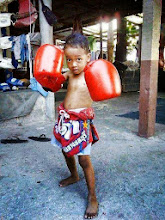.jpg) Nai Khanom Tom
Nai Khanom TomMost of what is known about the early history of Thai Boxing comes from the Burmese accounts of warfare between Myanmar (Burma) and Thailand during the 15th and 16th centuries. The earliest reference mentions a ferocious style of unarmed combat that decided the fate of the Thai Kings.
King Naresuan the Great (1555 – 1605) was supposed to be a top class boxer himself, and he made Muay Thai a required part of military training for all Thai soldiers. Later another Thai King, Phra Chao Seua (The Tiger King) further promoted Thai boxing as a national sport by encouraging prize fights and the development of training camps in the early 18th century. The Tiger King himself was said to be an excellent boxer and often would enter local competitions wearing disguises and defeat local champions. Combatants’ fists were wrapped in thick horse hair for maximum impact with minimum knuckle damage. They also used cotton soaked in glue and ground glass and later hemp. Tree bark and seashells were used to protect the groin from lethal kicks.
In 1774 Nai Khanom Tom was a prisoner of war in Burma. The Burmese had captured him when they sacked and burned Thailand’s ancient capital Ayuthaya. King Mangra of Burma left his capital in the north at Krung Angwa to travel to Rangoon – today’s capital – to attend a religious ceremony. The celebrations incorporated many entertainments, sports and games including Thai Boxing.
The Burmese had their own martial art – one unlike Muay Thai called Parma. Parma relied heavily on the fist as the major weapon, whereas Thai boxers were famous then, as they are now, for their skill in using elbows, knees, feet, as well as fists in a fight. King Mangra wanted to see which fighting skill was superior and called for the best Thai boxer from the captured prisoners to fight his Burmese fighters. Nai Khanom Tom was the natural choice of the Thais as he was renowned for his Muay Thai skills. The scene was very different from today’s fights. No timekeepers, no rounds, no gloves – just the hands and forearms bound in hemp ropes. It was a bare knuckle fight to the finish, not in a ring, but an arena flanked by the pomp and panoply of a Burmese court fresh from victory.
There were basic differences between the two fighting styles. The Burmese boxers wore a traditional ankle length sarong in which they danced, almost in slow motion, around their opponent, waiting and looking for an opening. The Burmese relied on fists more than feet, knees and elbows. The Thais, on the other hand, fought in a traditional loincloth wrapped once around the body and tied in a knot at the back and used everything they could. Nai Khanom Tom had then a freedom of movement and mobility his opponent lacked.
Nai Khanom Tom must have been a greater fighter. Without pause, he took them on, one by one through a battering and bruising content. He defeated 12 of Burma’s best. King Mangra was one of the first to applaud the feat he had witnessed. ‘Every part of the Thai is blessed with venom. Even with his bare hands he can fell nine or ten opponents’. The King gave Nai Khanom Tom his freedom and he returned to Thailand and hero’s welcome. The Thais badly needed a morale booster after the crushing defeat they had suffered at Ayuthaya.
For the Thai people, the legend of Nai Khanom Tom illustrates the best attributes of Muay Thai; the indomitable will to win for an honour other than the boxer’s own; willingness to face any odds in defence of the fighting art. Above all, Nai Khanom Tom symbolises the belief that the Thais have in their martial art – the belief that nothing can stand against it except itself. It’s a belief that has been proved right again and again. Every March 17, the Thai people honour Nai Khanom Tom. That night is ‘Boxers night’ at every stadium in the country and is dedicated to Nai Khanom Tom and his exceptional skill and valour.
No-one trained in any other martial art has been able to defeat a ranking Thai nák muay (fighter trained in Muay Thai) and many martial art experts consider the Thai style the ultimate in hand-to-hand fighting. On one famous occasion, Hong Kong’s top five Kung Fu masters were dispatched in less than 6½ minutes, all knock-outs. Hong Kong, China, Singapore, Taiwan, Korea, Japan, USA, The Netherlands, Germany and France have all sent their best and none of the challengers has yet beaten a top-ranked Ratchadamnoen/Lumpini Thai boxer.


